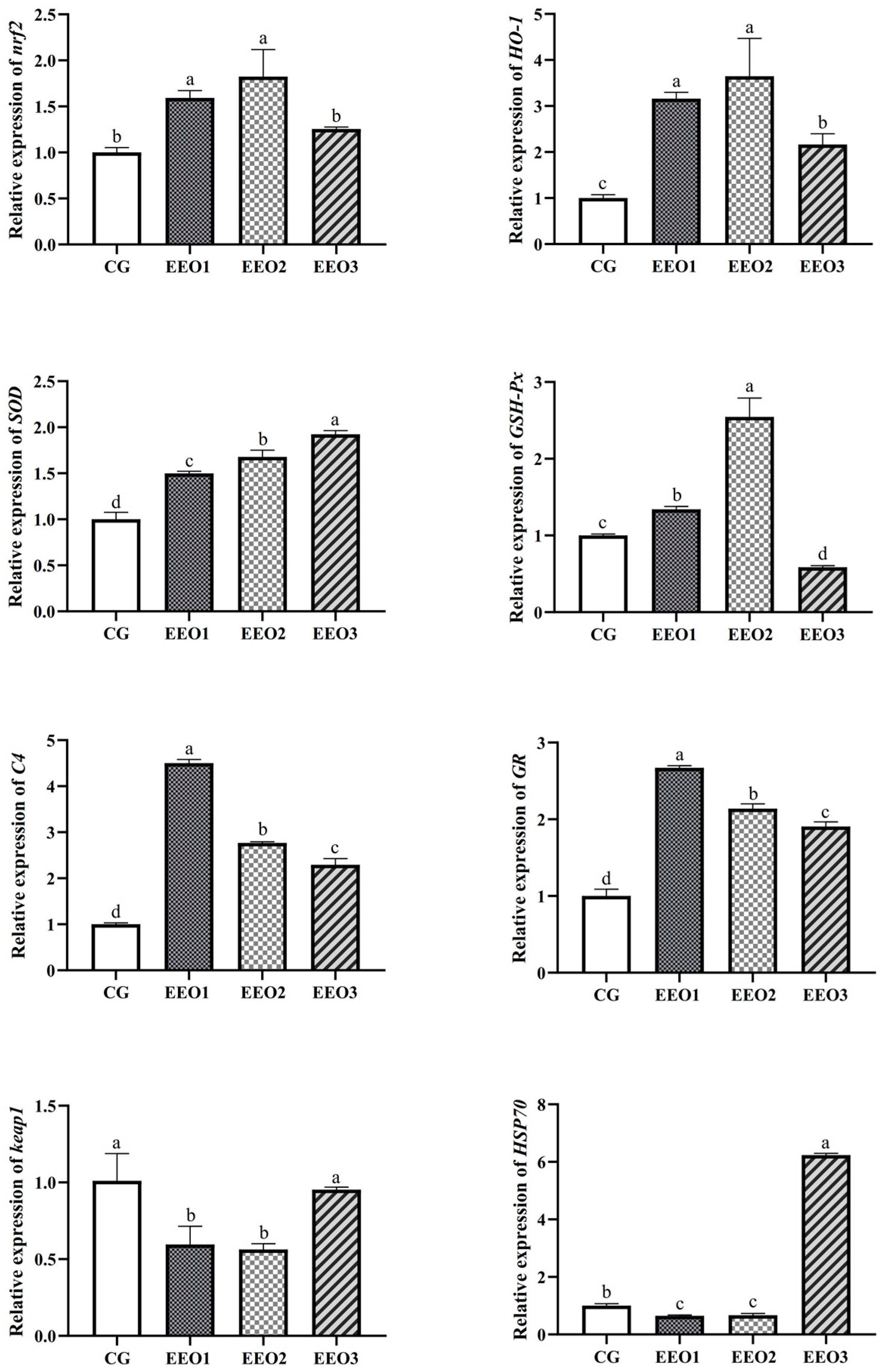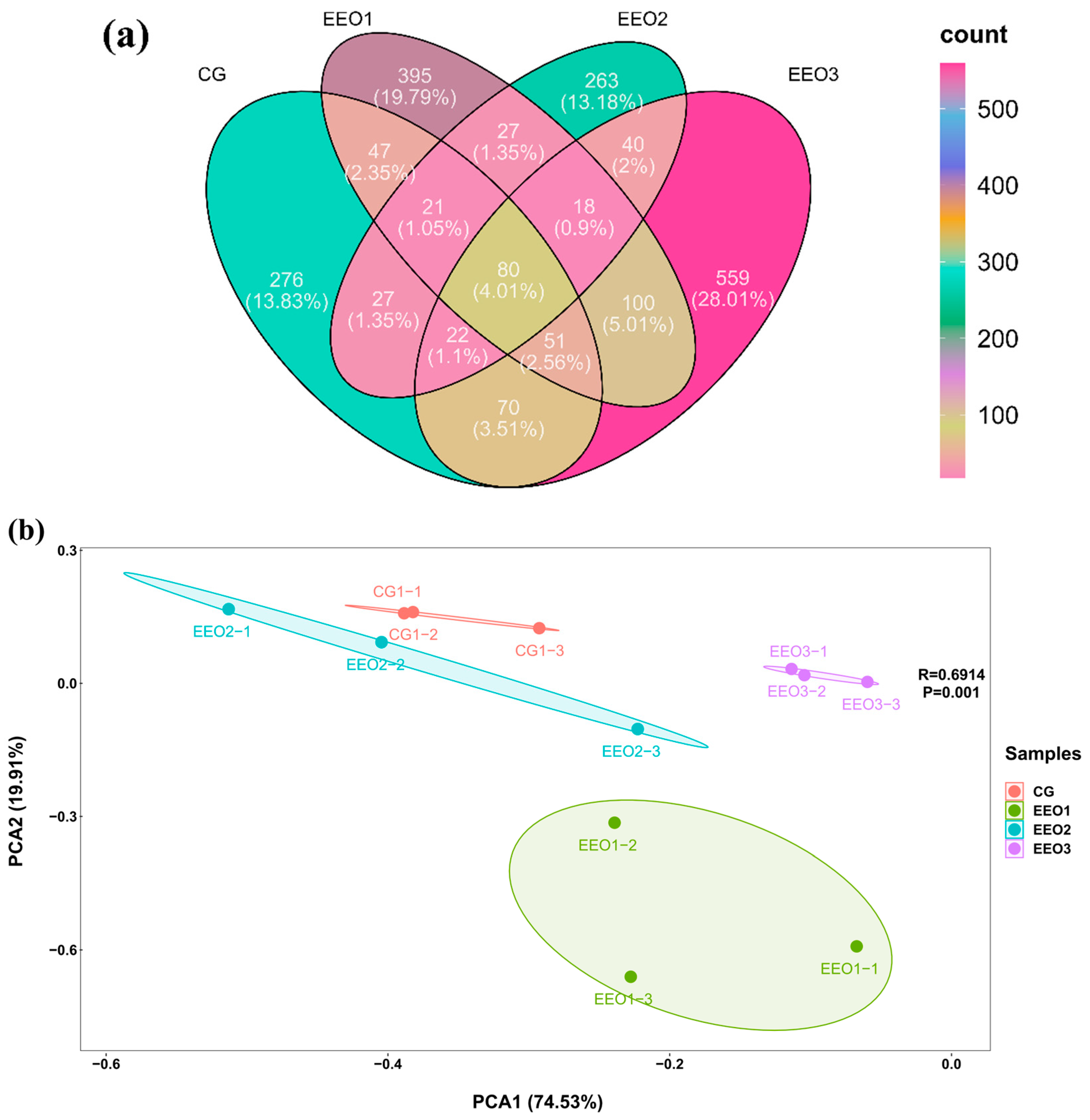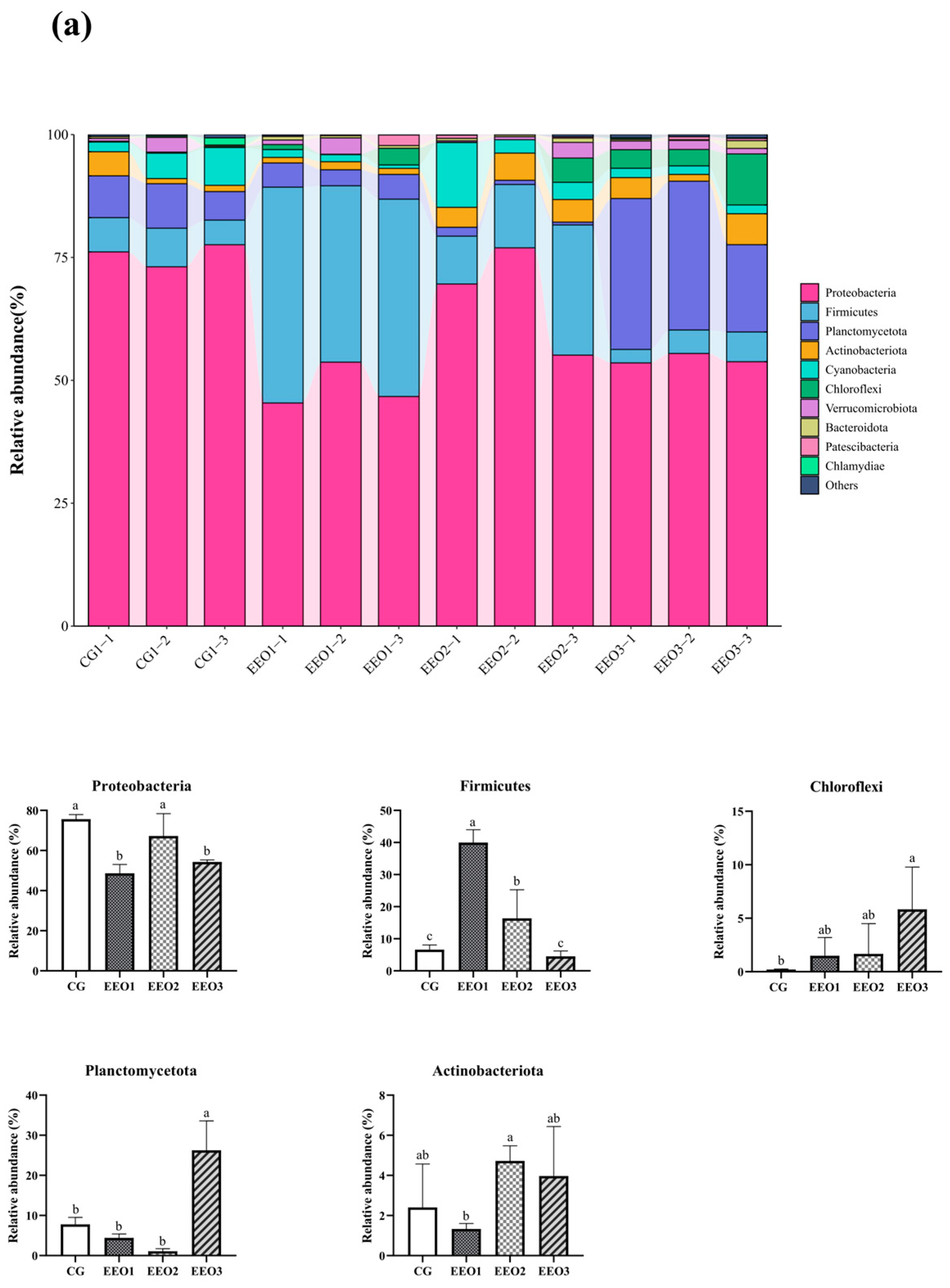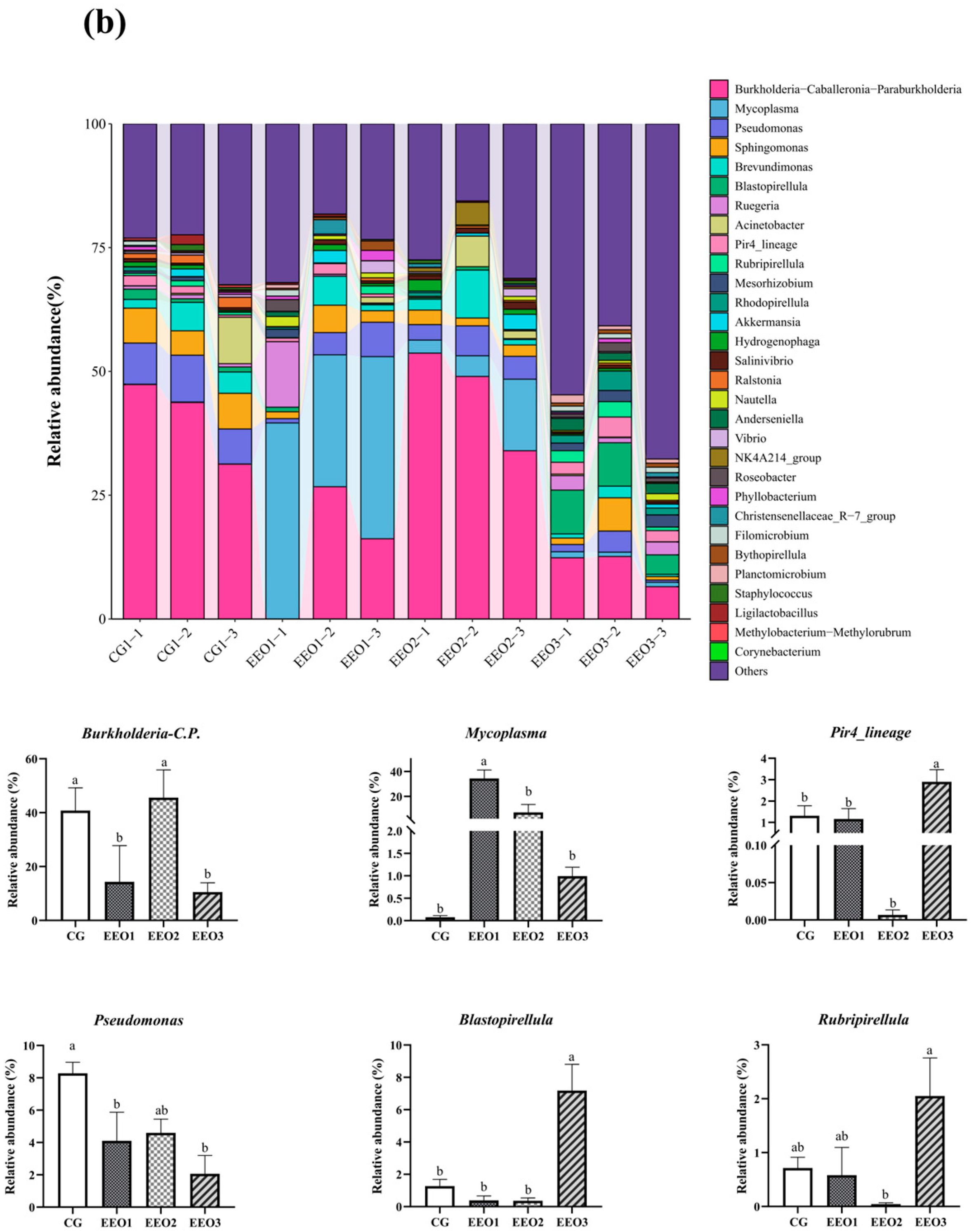Effects of Eucalyptus Essential Oil on Growth, Immunological Indicators, Disease Resistance, Intestinal Morphology and Gut Microbiota in Trachinotus ovatus
Abstract
1. Introduction
2. Materials and Methods
2.1. Diets and Fish
2.2. Sampling
2.3. Intestinal Morphology
2.4. Antioxidant Enzyme Activities and Immune-Related Gene Expression in Liver
2.5. Colonization of Streptococcus Iniae in Fish
2.6. Intestinal Microbiota Analysis
2.7. Data Analysis
3. Results
3.1. Growth and Intestinal Morphology
3.2. Hepatic Antioxidative Ability
3.3. Tissue Bacterial Load Following Challenge with S. iniae B240703
3.4. Intestinal Microbiota
4. Discussion
5. Conclusions
Supplementary Materials
Author Contributions
Funding
Institutional Review Board Statement
Informed Consent Statement
Data Availability Statement
Conflicts of Interest
References
- Manduca, L.G.; da Silva, M.A.; de Alvarenga, E.R.; de Oliveira Alves, G.F.; Ferreira, N.H.; Teixeira, E.d.A.; Araujo Fernandes, A.F.; de Almeida e Silva, M.; Turra, E.M. Effects of different stocking densities on Nile tilapia performance and profitability of a biofloc system with a minimum water exchange. Aquaculture 2021, 530, 735814. [Google Scholar] [CrossRef]
- Yousefi, M.; Adineh, H.; Hoseini, S.M.; Hashemianfar, S.A.M.; Kulikov, E.V.; Petukhov, N.V.; Ryzhova, T.A. Effects of Laurus nobilis essential oil nano-particles on growth performance, antioxidant and immune responses to bacterial infection in Nile tilapia, Oreochromis niloticus. Aquaculture 2025, 596, 741821. [Google Scholar] [CrossRef]
- Xun, P.; Zhou, C.; Huang, X.; Huang, Z.; Yu, W.; Yang, Y.; Huang, J.; Wu, Y.; Wang, R.; Lin, H. Effects of dietary sodium acetate on intestinal health of juvenile Trachinotus ovatus based on multi-omics approach. Aquaculture 2023, 562, 738776. [Google Scholar] [CrossRef]
- Diler, O.; Gormez, O.; Diler, I.; Metin, S. Effect of oregano (Origanum onites L.) essential oil on growth, lysozyme and antioxidant activity and resistance against Lactococcus garvieae in rainbow trout, Oncorhynchus mykiss (Walbaum). Aquac. Nutr. 2017, 23, 844–851. [Google Scholar] [CrossRef]
- Heluy, G.M.; Ramos, L.R.V.; Pedrosa, V.F.; Sarturi, C.; Figueiredo, P.G.P.; Vidal, L.G.P.; Franca, I.d.F.; Pereira, M.M. Oregano (Origanum vulgare) essential oil as an additive in diets for Nile tilapia (Oreochromis niloticus) fingerlings reared in salinized water. Aquac. Res. 2020, 51, 3237–3243. [Google Scholar] [CrossRef]
- Sutili, F.J.; Gatlin, D.M.; Heinzmann, B.M.; Baldisserotto, B. Plant essential oils as fish diet additives: Benefits on fish health and stability in feed. Rev. Aquac. 2018, 10, 716–726. [Google Scholar] [CrossRef]
- Ahmadifar, E.; Yousefi, M.; Karimi, M.; Fadaei Raieni, R.; Dadar, M.; Yilmaz, S.; Dawood, M.A.O.; Abdel-Latif, H.M.R. Benefits of Dietary Polyphenols and Polyphenol-Rich Additives to Aquatic Animal Health: An Overview. Rev. Fish. Sci. Aquac. 2021, 29, 478–511. [Google Scholar] [CrossRef]
- Hossain, M.S.; Small, B.C.; Kumar, V.; Hardy, R. Utilization of functional feed additives to produce cost-effective, ecofriendly aquafeeds high in plant-based ingredients. Rev. Aquac. 2024, 16, 121–153. [Google Scholar] [CrossRef]
- Cardoso, L.; Owatari, M.S.; Chaves, F.C.M.; Furtado, W.E.; Honorato, L.A.; Agnes, J.P.; dos Santos, D.C.; Pedrosa, R.C.; Fontes, S.T.; Mourino, J.L.P.; et al. Lippia sidoides essential oil (Verbenaceae) improves inflammatory response and histological condition in Danio rerio. Aquac. Int. 2023, 31, 2665–2685. [Google Scholar] [CrossRef]
- Endris, J.; Govindan, N. Single-stage coloration and multiple finishing of cotton with eucalyptus leaves extracts. J. Nat. Fibers 2022, 19, 969–983. [Google Scholar] [CrossRef]
- Tanwar, A.K.; Jadhav, S.; Gore, D.D.; Singh, I.P. qNMR as an analytical technique for essential oils: Quantitative analysis of Eucalyptus tereticornis leaf oil. Chem. Pap. 2023, 77, 3241–3252. [Google Scholar] [CrossRef]
- Goodger, J.Q.D.; Woodrow, I.E. Selection gains for essential oil traits using micropropagation of Eucalyptus polybractea. For. Ecol. Manag. 2008, 255, 3652–3658. [Google Scholar] [CrossRef]
- Aziz, Z.A.A.; Nasir, H.M.; Ahmad, A.; Setapar, S.H.M.; Ahmad, H.; Noor, M.H.M.; Rafatullah, M.; Khatoon, A.; Kausar, M.A.; Ahmad, I.; et al. Enrichment of Eucalyptus oil nanoemulsion by micellar nanotechnology: Transdermal analgesic activity using hot plate test in rats’ assay. Sci. Rep. 2019, 9, 13678. [Google Scholar] [CrossRef]
- Barbosa, K.T.; Acosta, A.P.; Schulz, H.R.; de Santi, I.I.; Delucis, R.d.A.; Beltrame, R.; Gatto, D.A. Biochemical features of organic extractives from Eucalyptus and Corymbia woods using ethanol as a solvent. Maderas-Cienc. Tecnol. 2021, 23, 58. [Google Scholar] [CrossRef]
- Li, X.; Zhang, Y.; Zhang, Q.; Cao, A.; Feng, J. Eucalyptus essential oil exerted a sedative-hypnotic effect by influencing brain neurotransmitters and gut microbes via the gut microbiota-brain axis. Front. Pharmacol. 2024, 15, 1464654. [Google Scholar] [CrossRef]
- Wang, B.; Jia, M.; Fang, L.; Jiang, L.; Li, Y. Effects of eucalyptus oil and anise oil supplementation on rumen fermentation characteristics, methane emission, and digestibility in sheep. J. Anim. Sci. 2018, 96, 3460–3470. [Google Scholar] [CrossRef] [PubMed]
- Fazelan, Z.; Hoseini, S.M.; Yousefi, M.; Khalili, M.; Hoseinifar, S.H.; Van Doan, H. Effects of dietary eucalyptol administration on antioxidant and inflammatory genes in common carp (Cyprinus carpio) exposed to ambient copper. Aquaculture 2020, 520, 734988. [Google Scholar] [CrossRef]
- Mirghaed, A.T.; Fayaz, S.; Hoseini, S.M. Effects of dietary 1,8-cineole supplementation on serum stress and antioxidant markers of common carp (Cyprinus carpio) acutely exposed to ambient ammonia. Aquaculture 2019, 509, 8–15. [Google Scholar] [CrossRef]
- Bodur, T.; Manuel Afonso, J.; Montero, D.; Navarro, A. Assessment of effective dose of new herbal anesthetics in two marine aquaculture species: Dicentrarchus labrax and Argyrosomus regius. Aquaculture 2018, 482, 78–82. [Google Scholar] [CrossRef]
- Djenane, D.; Yangueela, J.; Amrouche, T.; Boubrit, S.; Boussad, N.; Roncales, P. Chemical composition and antimicrobial effects of essential oils of Eucalyptus globulus, Myrtus communis and Satureja hortensis against Escherichia coli O157:H7 and Staphylococcus aureus in minced beef. Food Sci. Technol. Int. 2011, 17, 505–515. [Google Scholar] [CrossRef] [PubMed]
- Mulyaningsih; Sporer, F.; Reichling, J.; Wink, M. Antibacterial activity of essential oils from Eucalyptus and of selected components against multidrug-resistant bacterial pathogens. Pharm. Biol. 2011, 49, 893–899. [Google Scholar] [CrossRef]
- Polito, F.; Kouki, H.; Khedhri, S.; Hamrouni, L.; Mabrouk, Y.; Amri, I.; Nazzaro, F.; Fratianni, F.; De Feo, V. Chemical Composition and Phytotoxic and Antibiofilm Activity of the Essential Oils of Eucalyptus bicostata, E. gigantea, E. intertexta, E. obliqua, E. pauciflora and E. tereticornis. Plants 2022, 11, 3017. [Google Scholar] [CrossRef]
- Ayed, A.; Caputo, L.; De Feo, V.; Elshafie, H.S.; Fratianni, F.; Nazzaro, F.; Hamrouni, L.; Amri, I.; Mabrouk, Y.; Camele, I.; et al. Antimicrobial, anti-enzymatic and antioxidant activities of essential oils from some Tunisian Eucalyptus species. Heliyon 2024, 10, e34518. [Google Scholar] [CrossRef] [PubMed]
- Park, J.-W.; Wendt, M.; Heo, G.-J. Antimicrobial activity of essential oil of Eucalyptus globulus against fish pathogenic bacteria. Lab. Anim. Res. 2016, 32, 87–90. [Google Scholar] [CrossRef]
- MARA. Chinese Fishery Statistical Yearbook; China Agriculture Press: Beijing, China, 2024. [Google Scholar]
- Chinese Pharmacopoeia Commission. Pharmacopoeia of the People’s Republic of China 2020 Edition; China Medical Science Press: Beijing, China, 2020; Volume I. [Google Scholar]
- Zhou, C.; Lin, H.; Huang, Z.; Wang, J.; Wang, Y.; Yu, W. Effects of dietary leucine levels on intestinal antioxidant status and immune response for juvenile golden pompano (Trachinotus ovatus) involved in Nrf2 and NF-κB signaling pathway. Fish Shellfish Immunol. 2020, 107, 336–345. [Google Scholar] [CrossRef] [PubMed]
- Xie, J.; Fang, H.; He, X.; Liao, S.; Liu, Y.; Tian, L.; Niu, J. Study on mechanism of synthetic astaxanthin and Haematococcus pluvialis improving the growth performance and antioxidant capacity under acute hypoxia stress of golden pompano (Trachinotus ovatus) and enhancing anti-inflammatory by activating Nrf2-ARE pathway to antagonize the NF-κB pathway. Aquaculture 2020, 518, 734657. [Google Scholar] [CrossRef]
- Tan, X.; Sun, Z.; Zhou, C.; Huang, Z.; Tan, L.; Xun, P.; Huang, Q.; Lin, H.; Ye, C.; Wang, A. Effects of dietary dandelion extract on intestinal morphology, antioxidant status, immune function and physical barrier function of juvenile golden pompano Trachinotus ovatus. Fish Shellfish Immunol. 2018, 73, 197–206. [Google Scholar] [CrossRef]
- Deng, Y.; Lin, Z.; Xu, L.; Jiang, J.; Cheng, C.; Ma, H.; Feng, J. A first report of Streptococcus iniae infection of the spotted sea bass (Lateolabrax maculates). Front. Vet. Sci. 2024, 11, 1404054. [Google Scholar] [CrossRef] [PubMed]
- Tian, P.; Huo, L.; Shi, Q.; Wang, B.; Xu, X.; Jing, Y.; Luo, Y.; Liu, J.-X. Essential oils promote the growth performance of grass carp, Chinese soft-shelled turtles, and zebrafish. Aquac. Int. 2025, 33, 59. [Google Scholar] [CrossRef]
- Metin, S.; Yigit, N.O.; Didinen, B.I.; Koca, S.B.; Ozmen, O.; Aslankoc, R.; Kara, N. Effects of sage (Salvia officinalis) essential oil on growth, health and antioxidant capacity of common carp (Cyprinus carpio). Vet. Res. Commun. 2024, 48, 911–921. [Google Scholar] [CrossRef] [PubMed]
- Magouz, F.I.; Amer, A.A.; Faisal, A.; Sewilam, H.; Aboelenin, S.M.; Dawood, M.A.O. The effects of dietary oregano essential oil on the growth performance, intestinal health, immune, and antioxidative responses of Nile tilapia under acute heat stress. Aquaculture 2022, 548, 737632. [Google Scholar] [CrossRef]
- Zaminhan-Hassemer, M.; Zagolin, G.B.; Perazza, C.A.; Barbosa, D.A.; Menegidio, F.B.; Coutinho, L.L.; Tizioto, P.; Silva Hilsdorf, A.W. Adding an essential oil blend to the diet of juvenile Nile tilapia improves growth and alters the gut microbiota. Aquaculture 2022, 560, 738581. [Google Scholar] [CrossRef]
- Shourbela, R.M.; El-Hawarry, W.N.; Elfadadny, M.R.; Dawood, M.A.O. Oregano essential oil enhanced the growth performance, immunity, and antioxidative status of Nile tilapia (Oreochromis niloticus) reared under intensive systems. Aquaculture 2021, 542, 736868. [Google Scholar] [CrossRef]
- Dawood, M.A.O.; Gewaily, M.S.; Sewilam, H. The growth performance, antioxidative capacity, and histological features of intestines, gills, and livers of Nile tilapia reared in different water salinities and fed menthol essential oil. Aquaculture 2022, 554, 738122. [Google Scholar] [CrossRef]
- Mirghaed, A.T.; Hoseini, S.M.; Ghelichpour, M. Effects of dietary 1,8-cineole supplementation on physiological, immunological and antioxidant responses to crowding stress in rainbow trout (Oncorhynchus mykiss). Fish Shellfish Immunol. 2018, 81, 182–188. [Google Scholar] [CrossRef] [PubMed]
- Chung, S.; Ribeiro, K.; Bibiano Melo, J.F.; Teixeira, D.V.; Oliveira Vidal, L.V.; Copatti, C.E. Essential oil from ginger influences the growth, haematological and biochemical variables and histomorphometry of intestine and liver of Nile tilapia juveniles. Aquaculture 2021, 534, 736325. [Google Scholar] [CrossRef]
- Ren, X.; Lu, X.; Tan, Y.; Xu, J.; Wang, F.; Zhang, Y.; Fang, H.; Feng, A.; Xie, E.; Song, J. Effects of dietary curcumin levels on the growth, intestinal morphology and microbiota, waste production and feed costs of golden pompano Trachinotus ovatus. Aquac. Rep. 2024, 39, 102486. [Google Scholar] [CrossRef]
- Mai, H.; Guo, X.; Wang, J.; Chi, S.; Dong, X.; Yang, Q.; Liu, H.; Zhang, S. Effects of dietary protein levels on intestinal tract histomorphology and microflora composition in juvenile pearl gentian grouper (Epinephelus lanceolatu ♂ × E. fuscoguttatus♀). J. Dalian Ocean Univ. 2020, 35, 63–70. [Google Scholar]
- Yang, J.; Hong, J.; Fu, Z.; Ma, Z. Effects of Dietary Curcumin on Growth and Digestive Physiology of Seriola dumerili. Front. Mar. Sci. 2022, 9, 862379. [Google Scholar] [CrossRef]
- Leonard, S.G.; Sweeney, T.; Bahar, B.; Lynch, B.P.; O’Doherty, J.V. Effect of dietary seaweed extracts and fish oil supplementation in sows on performance, intestinal microflora, intestinal morphology, volatile fatty acid concentrations and immune status of weaned pigs. Br. J. Nutr. 2011, 105, 549–560. [Google Scholar] [CrossRef] [PubMed]
- Xun, P.; Huang, Q.; Feng, D.; Yu, W.; Yang, Y.; Guo, X.; Lin, H. Effects of Dietary Sodium Propionate on Growth Performance, Fillet Texture, Hematologic and Plasma Biochemical Parameter, Immune Responses, and Intestine Histology of Juvenile Trachinotus ovatus. Aquac. Nutr. 2024, 2024, 9148613. [Google Scholar] [CrossRef]
- Wang, B.; Liu, Y.; Feng, L.; Jiang, W.-D.; Kuang, S.-Y.; Jiang, J.; Li, S.-H.; Tang, L.; Zhou, X.-Q. Effects of dietary arginine supplementation on growth performance, flesh quality, muscle antioxidant capacity and antioxidant-related signalling molecule expression in young grass carp (Ctenopharyngodon idella). Food Chem. 2015, 167, 91–99. [Google Scholar] [CrossRef]
- Meng, R.; Wu, S.; Chen, J.; Cao, J.; Li, L.; Feng, C.; Liu, J.; Luo, Y.; Huang, Z. Alleviating effects of essential oil from Artemisia vulgaris on enteritis in zebrafish via modulating oxidative stress and inflammatory response. Fish Shellfish Immunol. 2022, 131, 323–341. [Google Scholar] [CrossRef]
- Shukry, M.; Abd El-Kader, M.F.; Hendam, B.M.; Dawood, M.A.O.; Farrag, F.A.; Aboelenin, S.M.; Soliman, M.M.; Abdel-Latif, H.M.R. Dietary Aspergillus oryzae Modulates Serum Biochemical Indices, Immune Responses, Oxidative Stress, and Transcription of HSP70 and Cytokine Genes in Nile Tilapia Exposed to Salinity Stress. Animals 2021, 11, 1621. [Google Scholar] [CrossRef] [PubMed]
- Elbialy, Z.I.; Salah, A.S.; Elsheshtawy, A.; Elkatatny, N.M.; Fouad, A.M.; Abo-Al-Ela, H.G. Differential tissue regulation of nrf2/keap1 crosstalk in response to Aeromonas infection in Nile tilapia: A comparative study. Aquac. Int. 2024, 32, 361–381. [Google Scholar] [CrossRef]
- Zeng, L.; Ai, C.X.; Wang, Y.H.; Zhang, J.S.; Wu, C.W. Abrupt salinity stress induces oxidative stress via the Nrf2-Keap1 signaling pathway in large yellow croaker Pseudosciaena crocea. Fish Physiol. Biochem. 2017, 43, 955–964. [Google Scholar] [CrossRef]
- Li, Y.A.; Chen, Z.F.; Xiao, Y.Y.; Gao, F.; Zhan, F.B.; Lu, Z.J.; Huang, Z.P.; Wei, X.F.; Su, F.P.; Shi, F.; et al. The Keap1-Nrf2 signaling pathway regulates antioxidant defenses of Ctenopharyngodon idella induced by bacterial infection. Fish Shellfish Immunol. 2023, 137, 108686. [Google Scholar] [CrossRef] [PubMed]
- Feng, J.M.; Huang, Y.X.; Huang, M.L.; Li, X.; Amoah, K.; Huang, Y.; Jian, J.C. The immune function of heme oxygenase-1 (HO-1) from Nile tilapia (Oreochromis niloticus) in response to bacterial infection. Fish Shellfish Immunol. 2024, 151, 109703. [Google Scholar] [CrossRef]
- Lin, Y.; Miao, L.H.; Pan, W.J.; Huang, X.; Dengu, J.M.; Zhang, W.X.; Ge, X.P.; Liu, B.; Ren, M.C.; Zhou, Q.L.; et al. Effect of nitrite exposure on the antioxidant enzymes and glutathione system in the liver of bighead carp, Aristichthys nobilis. Fish Shellfish Immunol. 2018, 76, 126–132. [Google Scholar] [CrossRef] [PubMed]
- Li, L.S.; Shen, Y.B.; Xu, X.Y.; Yang, W.N.; Li, J.L. Fish complement C4 gene evolution and gene/protein regulatory network analyses and simulated stereo conformation of C4-MASP-2 protein complex. Fish Shellfish Immunol. 2020, 107, 54–63. [Google Scholar] [CrossRef] [PubMed]
- Schuermann, M.; Oppel, F.; Gottschalk, M.; Bueker, B.; Jantos, C.A.; Knabbe, C.; Huetten, A.; Kaltschmidt, B.; Kaltschmidt, C.; Sudhoff, H. The Therapeutic Effect of 1,8-Cineol on Pathogenic Bacteria Species Present in Chronic Rhinosinusitis. Front. Microbiol. 2019, 10, 2325. [Google Scholar] [CrossRef] [PubMed]
- Leichtle, A.; Lupatsii, M.; Graspeuntner, S.; Jeschke, S.; Penxova, Z.; Kurabi, A.; Ryan, A.F.; Rupp, J.; Pries, R.; Bruchhage, K.-L. Anti-inflammatory response to 1,8-Cineol and associated microbial communities in Otitis media patients. Sci. Rep. 2024, 14, 16362. [Google Scholar] [CrossRef]
- Her, L.; Kanjanasilp, J.; Chaiyakunapruk, N.; Sawangjit, R. Efficacy and Safety of Eucalyptus for Relieving Cough: A Systematic Review and Meta-Analysis of Randomized Controlled Trials. J. Integr. Complement. Med. 2022, 28, 218–226. [Google Scholar] [CrossRef]
- Hoseini, S.M.; Hoseinifar, S.H.; Van Doan, H. Effect of dietary eucalyptol on stress markers, enzyme activities and immune indicators in serum and haematological characteristics of common carp (Cyprinus carpio) exposed to toxic concentration of ambient copper. Aquac. Res. 2018, 49, 3045–3054. [Google Scholar] [CrossRef]
- Do-Huu, H.; Nguyen, H.T.N.; Vo, H.T. Effects of Dietary Mannan Oligosaccharides on Growth, Nonspecific Immunity and Tolerance to Salinity Stress and Streptococcus iniae Challenge in Golden Pompano, Trachinotus ovatus. Aquac. Nutr. 2023, 2023, 9973909. [Google Scholar] [CrossRef]
- Vallejos-Vidal, E.; Reyes-Lopez, F.; Teles, M.; MacKenzie, S. The response of fish to immunostimulant diets. Fish Shellfish Immunol. 2016, 56, 34–69. [Google Scholar] [CrossRef] [PubMed]
- Xun, P.; Lin, H.; Wang, R.; Huang, Z.; Zhou, C.; Yu, W.; Huang, Q.; Tan, L.; Wang, Y.; Wang, J. Effects of dietary vitamin B1 on growth performance, intestinal digestion and absorption, intestinal microflora and immune response of juvenile golden pompano (Trachinotus ovatus). Aquaculture 2019, 506, 75–83. [Google Scholar] [CrossRef]
- Xun, P.; Jiang, H.; Huang, Q.; Feng, D.; Lun, F.; Yang, K.; Wang, X.; Xiao, Y.; Jiao, S.; Guo, X.; et al. Effects of sodium acetate supplementation on hematologic parameter, carbohydrate metabolism and intestinal microbiota of juvenile Micropterus salmoides fed high carbohydrate diets. Aquac. Rep. 2024, 39, 102498. [Google Scholar] [CrossRef]
- Montero, D.; Rimoldi, S.; Torrecillas, S.; Rapp, J.; Moroni, F.; Herrera, A.; Gomez, M.; Fernandez-Montero, A.; Terova, G. Impact of polypropylene microplastics and chemical pollutants on European sea bass (Dicentrarchus labrax) gut microbiota and health. Sci. Total Environ. 2022, 805, 150402. [Google Scholar] [CrossRef] [PubMed]
- Godinho, O.; Devos, D.P.; Quinteira, S.; Lage, O.M. The influence of the phylum Planctomycetota in the environmental resistome. Res. Microbiol. 2024, 175, 104196. [Google Scholar] [CrossRef] [PubMed]
- Price, E.P.; Hornstra, H.M.; Limmathurotsakul, D.; Max, T.L.; Sarovich, D.S.; Vogler, A.J.; Dale, J.L.; Ginther, J.L.; Leadem, B.; Colman, R.E.; et al. Within-Host Evolution of Burkholderia pseudomallei in Four Cases of Acute Melioidosis. PLoS Pathog. 2010, 6, e1000725. [Google Scholar] [CrossRef] [PubMed]
- Tang, S.; Li, Y.; Huang, C.; Yan, S.; Li, Y.; Chen, Z.; Wu, Z. Comparison of Gut Microbiota Diversity Between Captive and Wild Tokay Gecko (Gekko gecko). Front. Microbiol. 2022, 13, 897923. [Google Scholar] [CrossRef]
- Huyben, D.; Jarau, M.; MacInnes, J.; Stevenson, R.; Lumsden, J. Impact of Infection with Flavobacterium psychrophilum and Antimicrobial Treatment on the Intestinal Microbiota of Rainbow Trout. Pathogens 2023, 12, 454. [Google Scholar] [CrossRef] [PubMed]
- Wang, Y.; Huang, J.-M.; Wang, S.-L.; Gao, Z.-M.; Zhang, A.-Q.; Danchin, A.; He, L.-S. Genomic characterization of symbiotic mycoplasmas from the stomach of deep-sea isopod Bathynomus sp. Environ. Microbiol. 2016, 18, 2646–2659. [Google Scholar] [CrossRef]
- Kallscheuer, N.; Wiegand, S.; Heuer, A.; Rensink, S.; Boersma, A.S.; Jogler, M.; Boedeker, C.; Peeters, S.H.; Rast, P.; Jetten, M.S.M.; et al. Blastopirellula retiformator sp. nov. isolated from the shallow-sea hydrothermal vent system close to Panarea Island. Antonie Van Leeuwenhoek Int. J. Gen. Mol. Microbiol. 2020, 113, 1811–1822. [Google Scholar] [CrossRef] [PubMed]
- Wang, L.; Tian, Y.; Li, Z.; Li, Z.; Chen, S.; Li, L.; Li, W.; Wang, Q.; Lin, H.; Li, B. Comparison of the gut microbiota composition between asymptomatic and diseased Epinephelus moara ♀ × Epinephelus lanceolatus ♂ with nervous necrosis virus infection. Aquac. Res. 2022, 53, 633–641. [Google Scholar] [CrossRef]








| Test Diets | Basic Diets 1 (g) | Eucalyptus Oil (mL) | Wine (mL) | Water (mL) |
|---|---|---|---|---|
| CG | 100 | 0 | 3 | 3 |
| EEO1 | 100 | 0.5 | 3 | 2.5 |
| EEO2 | 100 | 1 | 3 | 2 |
| EEO3 | 100 | 1.5 | 3 | 1.5 |
| Genes | Sequence | Source | |
|---|---|---|---|
| β-Actin | F | TGAACCCCAAAGCCAACAGG | [27] |
| R | CCGCAGGACTCCATACCAAG | ||
| nrf2 | F | AGCTTGGCCTTCATCAAAT | [27] |
| R | GAGTATGGCTGTCCTTCTTCA | ||
| keap1 | F | CAGATAGACAGCGTGGTGAAGGC | [28] |
| R | GACAGTGAGACAGGTTGAAGAACTCC | ||
| HO-1 | F | AGAAGATTCAGACAGCAGCAGAACAG | [28] |
| R | TCATACAGCGAGCACAGGAGGAG | ||
| GSH-Px | F | GCTGAGAGGCTGGTGCAAGTG | [28] |
| R | TTCAAGCGTTACAGCAGGAGGTTC | ||
| HSP70 | F | TTGAGGAGGCTGCGCACAGCTTGTG | [29] |
| R | ACGTCCAGCAGCAGCAGGTCCT | ||
| SOD | F | CCTCATCCCCCTGCTTGGTA | [28] |
| R | CCAGGGAGGGATGAGAGGTG | ||
| C4 | F | TGGAGAAAAAGTTAAAGGGGC | [29] |
| R | CAGGAAGGAAGTATGAGCGAGT | ||
| GR | F | GTGTGTGTGGGCAAGGAGGA | [29] |
| R | AGATGAGGTGGGGTGAATGG | ||
| Parameters | CG (0) | EEO1 (0.5%) | EEO2 (1.0%) | EEO3 (1.5%) |
|---|---|---|---|---|
| Observed_species | 272.67 ± 12.22 b | 186.67 ± 42.22 b | 196.00 ± 63.22 b | 428.00 ± 76.62 a |
| Shannon | 4.81 ± 0.31 b | 4.10 ± 0.38 b | 4.12 ± 0.63 b | 6.84 ± 0.29 a |
| Simpson | 0.86 ± 0.04 b | 0.86 ± 0.02 b | 0.82 ± 0.06 b | 0.98 ± 0.00 a |
| Chao1 | 276.18 ± 12.93 b | 190.77 ± 41.14 b | 197.34 ± 64.06 b | 431.08 ± 74.22 a |
| Goods_coverage | 1.00 ± 0.00 | 1.00 ± 0.00 | 1.00 ± 0.00 | 1.00 ± 0.00 |
| Pielou_e | 0.59 ± 0.03 b | 0.54 ± 0.04 b | 0.55 ± 0.08 b | 0.79 ± 0.02 a |
| Ace | 276.74 ± 11.75 b | 191.42 ± 40.68 b | 198.50 ± 64.61 b | 432.42 ± 74.92 a |
Disclaimer/Publisher’s Note: The statements, opinions and data contained in all publications are solely those of the individual author(s) and contributor(s) and not of MDPI and/or the editor(s). MDPI and/or the editor(s) disclaim responsibility for any injury to people or property resulting from any ideas, methods, instructions or products referred to in the content. |
© 2025 by the authors. Licensee MDPI, Basel, Switzerland. This article is an open access article distributed under the terms and conditions of the Creative Commons Attribution (CC BY) license (https://creativecommons.org/licenses/by/4.0/).
Share and Cite
Lin, Z.; An, S.; Zhou, C.; Chen, Y.; Gao, Z.; Feng, J.; Lin, H.; Xun, P.; Yu, W. Effects of Eucalyptus Essential Oil on Growth, Immunological Indicators, Disease Resistance, Intestinal Morphology and Gut Microbiota in Trachinotus ovatus. Microorganisms 2025, 13, 537. https://doi.org/10.3390/microorganisms13030537
Lin Z, An S, Zhou C, Chen Y, Gao Z, Feng J, Lin H, Xun P, Yu W. Effects of Eucalyptus Essential Oil on Growth, Immunological Indicators, Disease Resistance, Intestinal Morphology and Gut Microbiota in Trachinotus ovatus. Microorganisms. 2025; 13(3):537. https://doi.org/10.3390/microorganisms13030537
Chicago/Turabian StyleLin, Ziyang, Shengzhe An, Chuanpeng Zhou, Yaqi Chen, Zhenchuang Gao, Juan Feng, Heizhao Lin, Pengwei Xun, and Wei Yu. 2025. "Effects of Eucalyptus Essential Oil on Growth, Immunological Indicators, Disease Resistance, Intestinal Morphology and Gut Microbiota in Trachinotus ovatus" Microorganisms 13, no. 3: 537. https://doi.org/10.3390/microorganisms13030537
APA StyleLin, Z., An, S., Zhou, C., Chen, Y., Gao, Z., Feng, J., Lin, H., Xun, P., & Yu, W. (2025). Effects of Eucalyptus Essential Oil on Growth, Immunological Indicators, Disease Resistance, Intestinal Morphology and Gut Microbiota in Trachinotus ovatus. Microorganisms, 13(3), 537. https://doi.org/10.3390/microorganisms13030537







